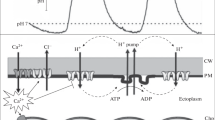Abstract
Internodal and whorl (branch) cells of the green alga,Chara corallina Klein ex Willd., em. R.D.W., were studied with the extracellular vibrating probe for measuring transmembrane ion currents, and with an extracellular pH microprobe for measuring the surface pH profile. Bands of positive inward current (OH- efflux) 1–3 mm wide were separated by wider bands of outward current (HCO -3 influx) along the length of the cell. The measured peaks of inward current ranged from 20 to 60 μA cm-2 (98 μm from the cell surface) which would correspond to a surface ionic flux of 270–800 pmol cm-2 s-1. The peaks of outward current (HCO -3 influx) ranged from 10 to 30 μA cm-2 which would correspond to a surface ionic flux of 140–400 pmol cm-2 s-1. The inward current bands matched the regions of surface alkalinity very well. The outward current (HCO -3 influx) was reduced at least 10-fold in low-HCO -3 medium, with a commensurate readjustment in the strength and pattern of inward current (OH- efflux). (Although these experiments involved a manipulation of the external pH, it is felt that the main adjustment in current patterns was in response to the reduction in exogenous HCO -3 ). The presence of the vibrating probe perturbed the inward current region when vibrating with a 26-μm amplitude, but this perturbation was eliminated when a 7-μm amplitude was used. The perturbation was usually observed as a reduction in the number of inward current peaks with an increase (approximate doubling) in the amplitudes of the one or two remaining peaks. Both the inward and outward currents were light-dependent, falling off within seconds of light removal.
Similar content being viewed by others
References
Ferrier, J.M., Lucas, W.J. (1979) Plasmalemma transport of OH- inChara corallina. II. Further analysis of the diffusion system associated with OH- efflux. J. Exp. Bot.30, 705–718
Ferrier, J.M., Morvan, C., Lucas, W.J., Dainty, J. (1979) Plasma lemma voltage noise inChara corallina. Plant Physiol.63, 709–714
Hansen, U.P. (1978) Do light-induced changes in the membrane potential ofNitella reflect the feed-back regulation of a cytoplasmic parameter? J. Membr. Biol.41, 197–224
Jaffe, L.F., Nuccitelli, R. (1974) An ultrasensitive vibrating probe for measuring extracellular currents. J. Cell Biol.63, 614–628
Keifer, D.W., Spanswick, R.M. (1978) Activity of the electrogenic pump inChara corallina as inferred from measurements of the membrane potential, conductance and potassium permeability. Plant Physiol.62, 653–661
Keifer, D.W., Spanswick, R.M. (1979) Correlation of adenosine triphosphate levels inChara corallina with the activity of the electrogenic pump. Plant Physiol.64, 165–168
Kitasato, H. (1968) The influence of H+ on the membrane potential and ion fluxes ofNitella. J. Gen. Physiol.52, 60–87
Lucas, W.J. (1975a) Photosynthetic fixation of14Carbon by internodal cells ofChara corallina. J. Exp. Bot.26, 331–346
Lucas, W.J. (1975b) The influence of light intensity on the activation and operation of the hydroxyl efflux system ofChara corallina. J. Exp. Bot.26, 347–360
Lucas, W.J. (1976) Plasmalemma transport of HCO −3 and OH− inChara corallina: non-antiporter systems. J. Exp. Bot.27, 19–31
Lucas, W.J. (1979) Alkaline band formation inChara corallina due to OH- efflux or H+ influx? Plant Physiol.63, 248–254
Lucas, W.J., Dainty, J. (1977a) HCO −3 influx across the plasmalemma ofchara corallina: divalent cation requirement. Plant Physiol.60, 862–867
Lucas, W.J., Dainty, J. (1977b) Spatial distribution of functional OH- carriers along a characean internodal cell: determined by the effect of cytochalasin B on H14CO −3 assimilation. J. Membr. Biol.32, 75–92
Lucas, W.J., Ferrier, J.M. (1980) Plasmalemma transport of OH- inChara corallina. III. Further studies on transport substrate and directionality. Plant Physiol.66, 46–50
Lucas, W.J., Ferrier, J.M., Dainty, J. (1977) Plasmalemma transport of OH- inChara corallina: dynamics of activation and deactivation. J. Membr. Biol.32, 49–73
Lucas, W.J., Shimmen, T. (in press) Intracellular perfusion and cell centrifugation studies on plasmalemma transport processes inChara corallina. J. Membr. Biol.
Lucas, W.J., Smith, F.A. (1973) The formation of alkaline and acid regions at the surface ofChara corallina cells. J. Exp. Bot.24, 1–14
Nuccitelli, R., Poo, M.-M., Jaffe, L.F. (1977) Relations between ameboid movements and membrane-controlled electrical currents. J. Gen. Physiol.69, 743–763
Ogata, K., Kishimoto, U. (1976) Rhythmic change of membrane potential and cyclosis ofNitella internode. Plant Cell Physiol.17, 201–207
Rao, R.L., Pickard, W.F. (1976) The use of membrane electric noise in the study of characean electrophysiology. J. Exp. Bot.27, 460–472
Rao, R.L., Pickard, W.F. (1977) Further experiments on the low frequency excess noise in the vacuolar resting potential ofChara braunii. J. Exp. Bot.28, 1–16
Sanders, D. (1980) The mechanism of Cl- transport at the plasma membrane ofChara corallina. I. Co-transport with H+. J. Membr. Biol.53, 129–141
Spanswick, R.M. (1972) Evidence for an electrogenic ion pump inNitella translucens. I. The effects of pH, K+, Na+, light and temperature on the membrane potential and resistance. Biochim. Biophys. Acta288, 73–89
Tazawa, M., Kikuyama, M., Nakagawa, S. (1975) Open-vacuole method for measuring membrane potential and membrane resistance of Characeae cells. Plant Cell Physiol.16, 611–622
Ueda, T., Kurihara, K., Kobatake, Y. (1975) Response ofNitella internodal cell to chemical stimulation: a model for olfactory receptor system. J. Membr. Biol.25, 271–284
Walker, N.A., Smith, F.A. (1977) Circulating electric currents between acid and alkaline zones associated with HCO −3 assimilation inChara. J. Exp. Bot.28, 1190–1206
Author information
Authors and Affiliations
Rights and permissions
About this article
Cite this article
Lucas, W.J., Nuccitelli, R. HCO -3 and OH-transport across the plasmalemma ofChara . Planta 150, 120–131 (1980). https://doi.org/10.1007/BF00582354
Received:
Accepted:
Issue Date:
DOI: https://doi.org/10.1007/BF00582354




